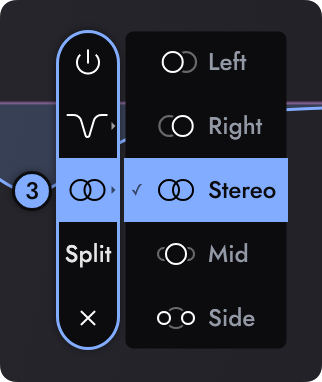Stereo tone shaping
Overview


On stereo tracks Claro bands can be set to process the overall stereo signal (processing left and right channels equally), or set to process only the Left, Right, Mid, or Side sub-channel. This allows sub-channels to be processed differently, for example to boost Definition on the left while attenuating Definition on the right in order to bring right-heavy hi-hats in a drum loop into the centre.
To change the channel that a band is processing, Right Click on the band and select from the Channel menu. Alternatively, click the Split button to duplicate the band across multiple channels. A Stereo/Left/Right band splits into → Left & Right, while a Mid/Side band splits into → Mid & Side
Here are some examples where sub-channel bands are useful when processing a stereo drum loop
- Boost a Left channel band to shift mono parts of the spectrum (e.g. the Body of a snare) towards the Left to clear space for another mix element, such as a lead synth line or vocal hook. Such shifting to the left can be made more effective by simultaneously attenuating the same frequency range on the Right channel
- Attenuate low frequency resonances in the Mid channel to fix a muddy or boomy sounding kick without attenuating low frequency stereo ambience
- Boost Body or Presence in the Side channel to enhance stereo ambience without drastically changing the overall tone of the signal
Width and mid/side tone shaping
Claro's Produce view Width section uses Side channel bands to adjust the stereo image. This is particularly useful, for example, to quickly mono or centre the Low end by Low Cut filtering the Side channel, or to enhance ambience by boosting Presence or Definition on the Side channel with a wide Bell or smooth High Shelf.
- Tweak and Mix views provide more control over these Side channel bands, and allow bands to process only the Mid channel.
-
Mid channel bands process only the mono components of a stereo signal - only those components which are heard in the centre of the stereo image.
-
Side channel bands process only the wide stereo components - only those which are heard towards the left and right sides of the stereo image.
Side channel Width processing is achieved by processing the difference between the left and right channels. Because of this, we advise being careful when boosting Side channel bands. Drastically increasing the difference between the left and right channels of a stereo signal can, rather than sounding increasingly wide, begin to sound unnatural. In some cases, extreme Side channel boosting can result in poor mono-compatibility of your mix, where wide stereo frequency ranges are too quiet when the mix is played on a mono system.